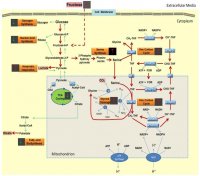Terma
Member
- Joined
- May 8, 2017
- Messages
- 1,063
So I was slowly embarking on MR, but planned to use NAC from time to time.
Turns out it's a great way to sabotage MR:
http://www.metabolismjournal.com/article/S0026-0495(12)00387-3/abstract
Which is because of:
Cysteine supplementation reverses methionine restriction effects on rat adiposity: significance of stearoyl-coenzyme A desaturase
I don't know if this has been posted, I only saw one poster mention something of the sort, but seemed worth it.
Turns out it's a great way to sabotage MR:
http://www.metabolismjournal.com/article/S0026-0495(12)00387-3/abstract
Objectives
Methionine-restricted (MR) rats, which are lean and insulin sensitive, have low serum total cysteine (tCys) and taurine and decreased hepatic expression and activity indices of stearoyl-coenzyme A desaturase-1 (SCD1). These effects are partly or completely reversed by cysteine supplementation. We investigated whether reversal of MR phenotypes can be achieved by other sulfur compounds, namely taurine or N-acetylcysteine (NAC).
Methods
MR and control-fed (CF) rats were supplemented with taurine (0.5%) or NAC (0.5%) for 12 weeks. Adiposity, serum sulfur amino acids (SAA), Scd1 gene expression in liver and white adipose tissue, and SCD1 activity indices (calculated from serum fatty acid profile) were monitored.
Results
Taurine supplementation of MR rats did not restore weight gain or hepatic Scd1 expression or indices to CF levels, but further decreased adiposity. Taurine supplementation of CF rats did not affect adiposity, but lowered triglyceridemia. NAC supplementation in MR rats raised tCys and partly or completely reversed MR effects on weight, fat %, Scd1 expression in liver and white adipose tissue, and estimated SCD1 activity. In CF rats, NAC decreased body fat % and lowered SCD1-18 activity index (P<0.001). Serum triglycerides and leptin were over 40% lower in CF+NAC relative to CF rats (P≤0.003 for both). In all groups, change in tCys correlated with change in SCD1-16 index (partial r=0.60, P<0.001) independent of other SAA.
Conclusion
The results rule out taurine as a mediator of increased adiposity produced by cysteine in MR, and show that NAC, similar to L-cysteine, blocks anti-obesity effects of MR. Our data show that dietary SAA can influence adiposity in part through mechanisms that converge on SCD1 function. This may have implications for understanding and preventing human obesity.
Which is because of:
Cysteine supplementation reverses methionine restriction effects on rat adiposity: significance of stearoyl-coenzyme A desaturase
Stearoyl-CoA desaturase-1 (SCD1) is a key enzyme in fatty acid and energy metabolism, but little is known about its nutritional regulation. Dietary methionine restriction in rats decreases hepatic Scd1 mRNA and protein, increases energy expenditure, and decreases fat-pad mass/body-weight% (FM/BW%). In humans, plasma concentrations of the methionine product, cysteine, are associated with obesity. To determine which consequences of methionine-restriction are mediated by decreased cysteine availability, we monitored obesity-related variables in 4 dietary groups for 12 weeks: control-fed (CF), methionine-restricted (MR), MR supplemented with 0.5% l-cysteine (MR+Cys) and CF+Cys rats. MR lowered weight gain and FM/BW% despite higher food intake/weight than CF, and lowered serum cysteine. Hepatic Scd1 expression was decreased, with decreased serum SCD1 activity indices (calculated from serum fatty acid profile), decreased serum insulin, leptin and triglycerides, and higher adiponectin. Cysteine supplementation (MR+Cys) essentially reversed all these phenotypes and raised serum cysteine but not methionine to CF levels. Adding extra cysteine to control diet (CF+Cys) increased serum taurine but did not affect serum cysteine, lipids, proteins, or total weight gain. FM/BW% and serum leptin were modestly decreased. Our results indicate that anti-obesity effects of MR are caused by low cysteine and that dietary sulfur amino acid composition contributes to SCD1 regulation.
I don't know if this has been posted, I only saw one poster mention something of the sort, but seemed worth it.

